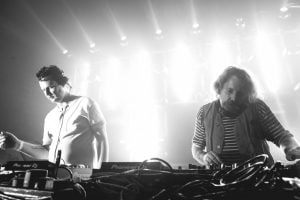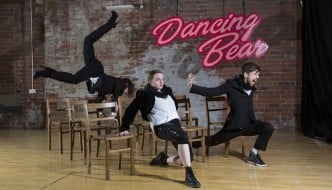
In an interview in 2015 Ed Simons, one half of the Chemical Brothers, said that “Continually harking back to some golden age is daft [. . .] It’s like people in the 80s wanting to make records that sound like Tommy Steele. It’s a long time ago now, isn’t it?” As Simmons and other half of the duo, Tom Rowlands, take to the stage at Manchester’s Warehouse Project and start their DJ set with an extended mix of ‘Go’, from their 2015 album ‘Born In Echoes’, it’s not hard to see why the Chemical Brothers are still considered to be at the forefront of Big beat electronica, a genre they became progenitors of in the early ‘90s, alongside the likes of Fatboy Slim, The Prodigy et al.
The bill for the evening is a finely curated one, and gives an almost ethnographic overview of electronic dance music, with stalwarts Andrew Weatherall, Sean Johnston, James Holroyd, and Krysko, mixed in with members of the new guard: Daniel Avery, Holly Lester, and Cousn. There is also a cyclical feeling to the Chemical Brothers playing on the same bill as Weatherall, given that he helped the duo early on in their career, playing their ‘Song to the Siren’ regularly in his sets, before releasing the track on his record label Junior Boy’s Own.
There is a sense of “the boys have come home” as the Chemical Brothers’ return to Manchester; having cemented their friendship while studying at the university here, there are rumours of the duo playing their first dj set in one of the student halls buildings down the Oxford Road, as well as references to their Manchester heritage in their early name “The 237 Turbo Nutters”, a nod to the house they lived in on Dickenson Road in Rusholme. Yet while previous years have seen them play live shows in the city where they developed as musicians, their slot at Warehouse Project sees them return to the decks, stripping back their huge banks of synthesisers, sequencers, and projections, in favour of a simpler set-up reminiscent of their embryonic “Turbo Nutters” stage. It is almost like the Chemical Brothers before they ever were.
The music from all the acts playing is varied, moving through house and techno’s nuanced sub-genres, often, albeit, without me even noticing. Something striking, however, was the temporal breadth of tracks played, with a diverse array of early house, followed by tracks that had been made within the last couple of months. It signposted an open mindedness that is undoubtedly one of dance music’s greatest assets, and something that is often avoided in other genres. Weatherall and Johnston’s set is a prime example of this; presenting their night ‘a love from outer space’, something they describe as ‘an oasis of slow in a world of increasing velocity’, they flit through time and space, playing a Parrot and Cocker Too remix of Baxter Dury’s ‘Miami’, a track that came out in mid-October, followed by an obscure Norwegian house-disco track by Laars, followed by ‘Rising Up’, a Deafcon recordings track by UDM.
While the performers’s diversity and penchant for obscurity would have been something lauded back in the pre-internet ‘80s and ‘90s, when the likes of Weatherall, Johnston, and the Chemical Brothers started making names for themselves, one has to wonder whether, in a time of crowd-sourced music knowledge — one only has to post a ten second clip of a song on the right Facebook group to learn what it is — diversity and obscurity are still the traits that set certain djs and dance acts apart.
This is answered with the Chemical Brothers’ arrival on stage. They weave seamlessly between new tracks from Redshape and David Salow, to fan favourites of their own, tying together threads of dance music from multiple decades. While they were praised for their prowess at the decks in the ‘90s, one has to remember that now, over twenty years on from their early sets in the backs of pubs, they have a catalogue of eight studio albums of their own music that they could play from, not to mention countless remixes too. It is perhaps this that sets acts of their calibre apart from their contemporaries. While The Quietus hailed Daniel Avery as ‘The new breed of superstar DJ’ back in 2013 after the release of his debut album, the Chemical Brothers have been, and are still, superstar djs, having coined the term in 1999.
The sheer length of time devoted to their craft means that the Chemical Brothers have not only had a lot of practice, but that they’re now refined professionals, with a back catalogue of floor-fillers for them to dip into when feeling nostalgic. They display variety, as well as a keen sense of the crowd, something that, I imagine, takes hours of playing to develop. There is, also, a mutual sense of respect that pervades the cavernous arches under Piccadilly Station; the crowd is as diverse as the set, and thus pays homage to a genre that, more often than not, defies age stigmas often present in other musical spheres — the new guard gum-munchers mix with the 808 State era originals, in the veneration of the true ‘superstar djs’.




Comments